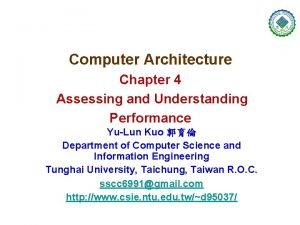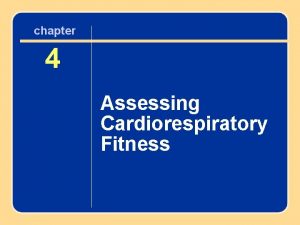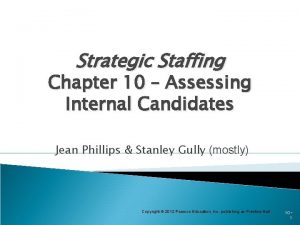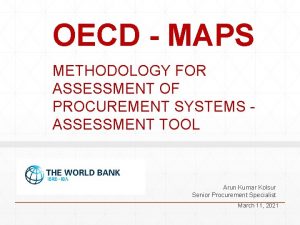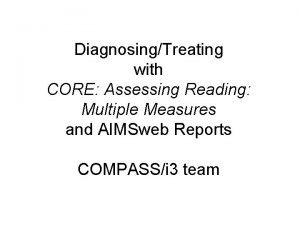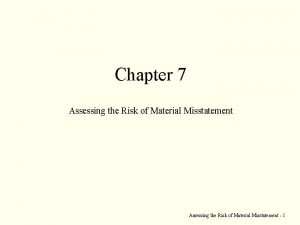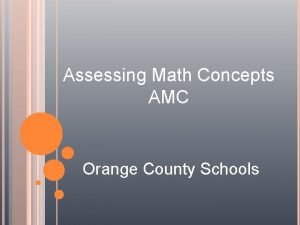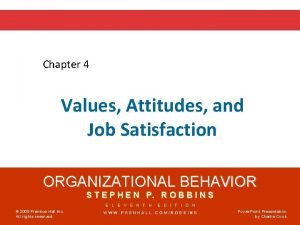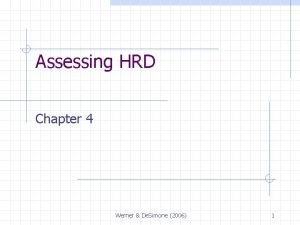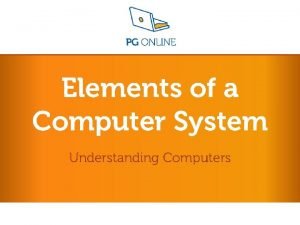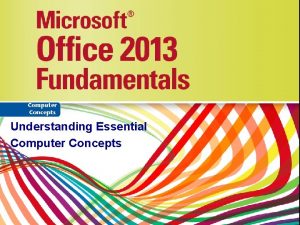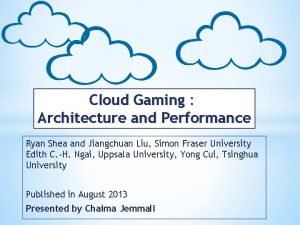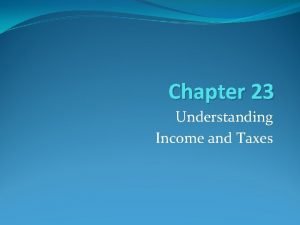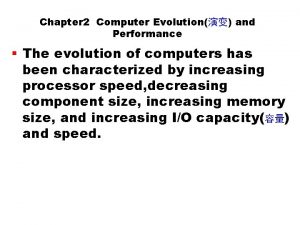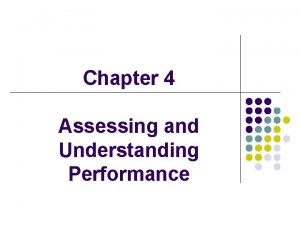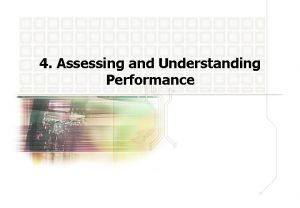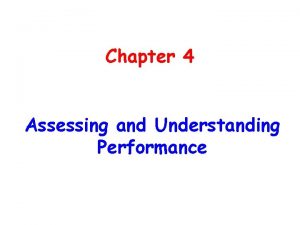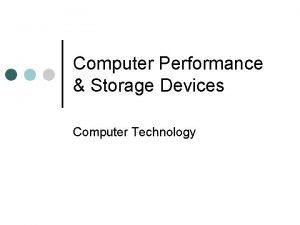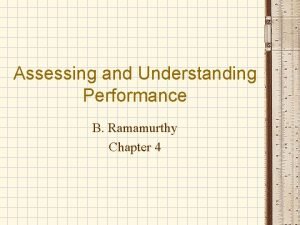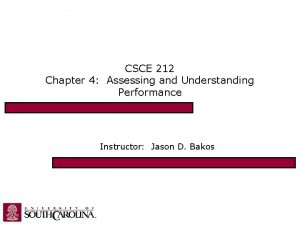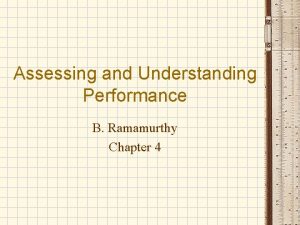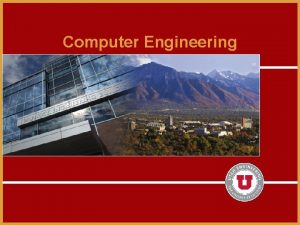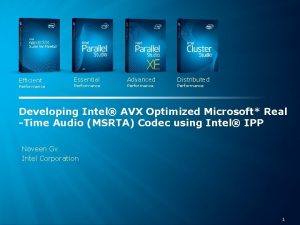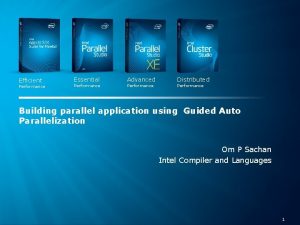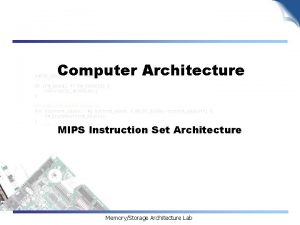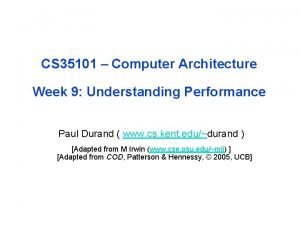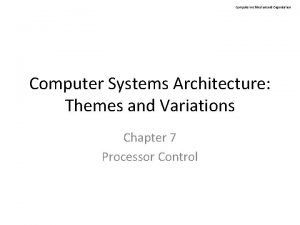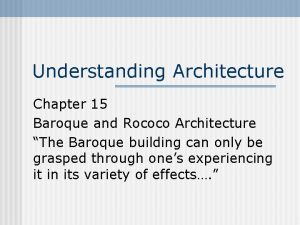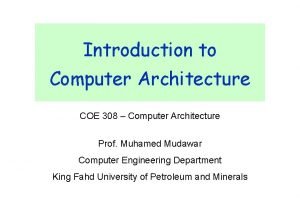Computer Architecture Chapter 4 Assessing and Understanding Performance





















































- Slides: 53

Computer Architecture Chapter 4 Assessing and Understanding Performance Yu-Lun Kuo 郭育倫 Department of Computer Science and Information Engineering Tunghai University, Taichung, Taiwan R. O. C. sscc 6991@gmail. com http: //www. csie. ntu. edu. tw/~d 95037/

Opening Indeed, the cost-performance ratio of the product will depend most heavily on the implementer, just as ease of use depends most heavily on the architect. The Mythical Man-Month, Brooks 2

Introduction • • Measure, Report, and Summarize Make intelligent choices See through the marketing hype Key to understanding underlying organizational motivation – Why is some hardware better than others for different programs? – What factors of system performance are hardware related? (e. g. , Do we need a new machine, or a new operating system? ) – How does the machine’s instruction set affect performance? 3

Best Performance • How much faster is the Concorde compared to the 747? Response Time • How much bigger is the 747 than the Douglas DC-8? Throughput

Performance Metrics • Purchasing perspective – given a collection of machines, which has the • best performance ? • least cost ? • best cost/performance? • Design perspective – faced with design options, which has the • best performance improvement ? • least cost ? • best cost/performance? 5

Performance Metrics • Both require – Basis for comparison – Metric for evaluation • Our goal is to understand what factors in the architecture – Contribute to overall system performance – The relative importance (and cost) of these factors 6

Computer Performance • Response Time (latency)(execution time) – The total time required for the computer to compute a task, including disk access, memory access, I/O activities, OS overhead, CPU execution time, and so on. • How long does it take for my job to run? • How long does it take to execute a job? • How long must I wait for the database query? • Throughput (生產量) – How many jobs can the machine run at once? – What is the average execution rate? – How much work is getting done?

Computer Performance • If we upgrade a machine with a new processor what do we increase? • If we add a new machine to the lab what do we increase? 8

Measuring Performance • Elapsed Time – Counts everything (disk and memory accesses, I/O, etc. ) – A useful number, but often not good for comparison purposes • CPU time – Doesn’t count I/O or time spent running other programs – Can be broken up into system time, and user time • Our focus: user CPU time – Time spent executing the lines of code that are “in” our program

Example (Linux instruction) • Time instruction: “time” • > 90. 7 u 12. 9 s 2: 39 65% • CPU time ratio: (90. 7+12. 9) / 159 = 65% – I/O time more than 1/3 10

Book’s Definition of Performance • Normally interested in reducing – Response time (aka execution time) – the time between the start and the completion of a task • Important to individual users – Thus, to maximize performance, need to minimize execution time performance. X = 1 / execution_time. X If X is n times faster than Y, then performance. X execution_time. Y ---------- = ----------- = n performance. Y execution_time. X 11

Book’s Definition of Performance • Throughput – The total amount of work done in a given time • Important to data center managers • Decreasing response time almost always improves throughput 12

Book’s Definition of Performance • Problem: – Machine X runs a program in 10 seconds – Machine Y runs the same program in 15 seconds

Performance Factors • Want to distinguish elapsed time and the time spent on our task • CPU execution time (CPU time) – time the CPU spends working on a task – Does not include time waiting for I/O or running other programs 14

Performance Factors CPU execution time = # CPU clock cycles x clock cycle time for a program or CPU execution time = ---------------------# CPU clock cycles for a program clock rate q Can improve performance by reducing either the length of the clock cycle or the number of clock cycles required for a program 15

Clock Cycles • Instead of reporting execution time in seconds, we often use cycles – Clock “ticks” indicate when to start activities – Cycle time = time between ticks = seconds per cycle – Clock rate (frequency) = cycles per second (1 Hz = 1 cycle/sec) – A 4 GHz clock has a cycle time

Review: Machine Clock Rate • Clock rate (MHz, GHz) is inverse of clock cycle time (clock period) CC = 1 / CR one clock period 10 nsec clock cycle => 100 MHz clock rate 5 nsec clock cycle => 200 MHz clock rate 2 nsec clock cycle => 500 MHz clock rate 1 nsec clock cycle => 1 GHz clock rate 500 psec clock cycle => 2 GHz clock rate 250 psec clock cycle => 4 GHz clock rate 200 psec clock cycle => 5 GHz clock rate 17

How to Improve Performance • So, to improve performance (everything else being equal) you can either (increase or decrease? ) _decrease_ the # of required cycles for a program, or _decrease_ the clock cycle time or, said another way, _increase_ the clock rate.

How many cycles are required for a program? . . . 6 th 5 th 4 th 3 rd instruction 2 nd instruction 1 st instruction • Could assume that number of cycles equals number of instructions time – This assumption is incorrect, different instructions take different amounts of time on different machines. Why? hint: remember that these are machine instructions, not lines of C code

Different Numbers of Cycles for Different Instructions time • Multiplication takes more time than addition • Floating point operations take longer than integer ones • Accessing memory takes more time than accessing registers • Important point: changing the cycle time often changes the number of cycles required for various instructions (more later)

Improving Performance • Our favorite program runs in 10 seconds on computer A, which has a 4 GHz clock. • We are trying to help a computer designer build a new machine B, that will run this program in 6 seconds. – The designer can use new (or perhaps more expensive) technology to substantially increase the clock rate, but has informed us that this increase will affect the rest of the CPU design, causing machine B to require 1. 2 times as many clock cycles as machine A for the same program. What clock rate should we tell the designer to target?

Improving Performance

Improving Performance

Clock Cycles per Instruction (CPI) • Not all instructions take the same amount of time to execute – One way to think about execution time is that it equals the number of instructions executed multiplied by the average time per instruction # CPU clock cycles = for a program # Instructions for a program Average clock cycles x per instruction 24

Clock Cycles per Instruction (CPI) • Clock cycles per instruction (CPI) – The average number of clock cycles each instruction takes to execute – A way to compare two different implementations of the same ISA CPI for this instruction class A B C 1 2 3 25

Effective CPI • Computing the overall effective CPI is done by looking at the different types of instructions and their individual cycle counts and averaging n Overall effective CPI = i=1 l l l (CPIi x ICi) Where ICi is the count (percentage) of the number of instructions of class i executed CPIi is the (average) number of clock cycles per instruction for that instruction class n is the number of instruction classes 26

Performance Equation • Our basic performance equation is then CPU time = Instruction_count x CPI x clock_cycle or CPU time = Instruction_count x CPI -----------------------clock_rate 27

Determinates of CPU Performance • CPU time = Instruction_count x CPI x clock_cycle Instruction_ count CPI clock_cycle Algorithm Programming language Compiler ISA Processor organization Technology 28

Determinates of CPU Performance • CPU time = Instruction_count x CPI x clock_cycle Instruction_ count CPI X X Programming language X X Compiler X X X X Algorithm ISA Processor organization Technology clock_cycle X 29

CPI Example • Suppose we have two implementations of the same instruction set architecture (ISA). – For some program, Machine A has a clock cycle time of 250 ps and a CPI of 2. 0 – Machine B has a clock cycle time of 500 ps and a CPI of 1. 2 – What machine is faster for this program, and by how much? • If two machines have the same ISA which of our quantities (e. g. , clock rate, CPI, execution time, # of instructions, MIPS) will always be identical?

CPI Example (2) • 假設相同指令集架構(ISA)下的兩種機器設計 • 對某一個程式的執行 – Machine A has a clock cycle time of 10 ns. and a CPI of 2. 0 – Machine B has a clock cycle time of 20 ns. and a CPI of 1. 2 • 那一台機器比較快, 而且快多少? • 假使有兩台機器有相同的 ISA, 下面的那個計算效 能值不變(e. g. , clock rate, CPI, execution time, # of instructions, MIPS: million instructions per second)? 31

Improving Performance • 因為是同樣的程式在不同的機器上執行, 所以執行 的指令數相同, 但執行時間不同 • 假設這個程式有I個指令數 • CPU clock cycles. A=I*2. 0 • CPU clock cycles. B=I*1. 2 • CPU time = CPU clocks cycles * clock cycle time • CPU performance. A/CPU performance. B = Execution. B / Execution. A = (1. 2*20)/(2*10)=1. 2 32

Improving Performance

Now that We Understand Cycles • A given program will require – some number of instructions (machine instructions) – some number of cycles – some number of seconds • We have a vocabulary that relates these quantities: – cycle time (seconds per cycle) – clock rate (cycles per second) – CPI (cycles per instruction) a floating point intensive application might have a higher CPI – MIPS (millions of instructions per second) this would be higher for a program using simple instructions

Performance • Performance is determined by execution time • Do any of the other variables equal performance? – – – # of cycles to execute program? # of instructions in program? # of cycles per second? average # of cycles per instruction? average # of instructions per second?

Performance - Time 36

# of Instructions Example

# of Instructions Example

# of Instructions Example

Performance: What to measure • Usually rely on benchmarks vs. real workloads • To increase predictability, collections of benchmark applications-- benchmark suites -are popular • SPECCPU: popular desktop benchmark suite – – CPU only, split between integer and floating point programs SPECint 2000 has 12 integer, SPECfp 2000 has 14 integer pgms SPECCPU 2006 to be announced Spring 2006 SPECSFS (NFS file server) and SPECWeb (Web. Server) added as server benchmarks 40

Performance: What to measure • Transaction Processing Council measures server performance and cost-performance for databases – – TPC-C Complex query for Online Transaction Processing TPC-H models ad hoc decision support TPC-W a transactional web benchmark TPC-App application server and web services benchmark 41

Benchmarks • Performance best determined by running a real application – Use programs typical of expected workload – Or, typical of expected class of applications e. g. , compilers/editors, scientific applications, graphics, etc. • Small benchmarks – nice for architects and designers – easy to standardize – can be abused

Benchmarks • SPEC (System Performance Evaluation Cooperative) – companies have agreed on a set of real program and inputs – valuable indicator of performance (and compiler technology) – can still be abused

SPEC Benchmarks www. spec. org Integer benchmarks gzip compression vpr FPGA place & route gcc GNU C compiler mcf Combinatorial optimization crafty Chess program parser Word processing program eon Computer visualization perlbmk perl application gap vortex bzip 2 twolf Group theory interpreter Object oriented database compression Circuit place & route FP benchmarks wupwise Quantum chromodynamics swim Shallow water model mgrid Multigrid solver in 3 D fields applu Parabolic/elliptic pde mesa 3 D graphics library galgel Computational fluid dynamics art Image recognition (NN) equake Seismic wave propagation simulation facerec Facial image recognition ammp Computational chemistry lucas Primality testing fma 3 d Crash simulation fem sixtrack Nuclear physics accel apsi Pollutant distribution



MIPS example


MIPS Example

Amdahl’s Law • Execution Time After Improvement = – Execution Time Unaffected +( Execution Time Affected / Amount of Improvement ) • Example: "Suppose a program runs in 100 seconds on a machine, with multiply responsible for 80 seconds of this time. How much do we have to improve the speed of multiplication if we want the program to run 4 times faster? " How about making it 5 times faster? ? ? !! • Principle: Make the common case fast 54

Amdahl’s Law

Remember • Performance is specific to a particular program – Total execution time is a consistent summary of performance • For a given architecture performance increases come from – Increases in clock rate (without adverse CPI affects) – Improvements in processor organization that lower CPI – Compiler enhancements that lower CPI and/or instruction count – Algorithm/Language choices that affect instruction count

Textbook Contents • • • 1: Computer Abstractions and Technology 2: Instructions: Language of the Computer 3: Arithmetic for Computers 4: Assessing and Understanding Performance 5: The Processor: Datapath and Control 6: Enhancing Performance with Pipelining 7: Large and Fast: Exploiting Memory Hierarchy 8: Storage, Networks, and Other Peripherals 9: Multiprocessors and Clusters 57
 Difference between computer architecture and organization
Difference between computer architecture and organization Computer architecture performance evaluation methods
Computer architecture performance evaluation methods Microquill
Microquill Chapter 4 cultural dynamics in assessing global markets
Chapter 4 cultural dynamics in assessing global markets Assessing health status chapter 22
Assessing health status chapter 22 Three bus architecture
Three bus architecture Register in computer organization
Register in computer organization Ways to address grammar in the writing classroom
Ways to address grammar in the writing classroom Ppst domain 4
Ppst domain 4 Informal assessments
Informal assessments Assessing a new venture's financial strength and viability
Assessing a new venture's financial strength and viability Assessing leadership and measuring its effects
Assessing leadership and measuring its effects Module 4 topic 1 assessing and managing risk
Module 4 topic 1 assessing and managing risk Module 4 topic 1 assessing and managing risk
Module 4 topic 1 assessing and managing risk Assessing risk in sport
Assessing risk in sport Unit 18 assessing children's development support needs
Unit 18 assessing children's development support needs Assessing need for hrd
Assessing need for hrd Manual for assessing safety hardware
Manual for assessing safety hardware Assessing cardiorespiratory fitness
Assessing cardiorespiratory fitness A nine box matrix requires assessing employees on ________.
A nine box matrix requires assessing employees on ________. Methodology for assessing procurement systems
Methodology for assessing procurement systems Core graded high frequency word survey
Core graded high frequency word survey Acceptable audit risk
Acceptable audit risk Assessing math concepts
Assessing math concepts Assessing motivation to change
Assessing motivation to change Assessing opportunity cost involves
Assessing opportunity cost involves Hazard communication quiz answers
Hazard communication quiz answers Cultural dynamics in assessing global markets
Cultural dynamics in assessing global markets Assessing value for money
Assessing value for money Assessing parental capacity
Assessing parental capacity Group discussion is a modern method of assessing students
Group discussion is a modern method of assessing students The globe framework for assessing cultures
The globe framework for assessing cultures Cultural dynamics in assessing global markets
Cultural dynamics in assessing global markets Assessing the internal environment of the firm
Assessing the internal environment of the firm Assessing hrd needs
Assessing hrd needs Computersl
Computersl Understanding essential computer concepts
Understanding essential computer concepts Cloud gaming architecture and performance
Cloud gaming architecture and performance Call and return architecture in software architecture
Call and return architecture in software architecture Chapter 23 understanding income and taxes
Chapter 23 understanding income and taxes The ability to locate interpret and apply information
The ability to locate interpret and apply information Chapter 1 health and wellness fundamentals
Chapter 1 health and wellness fundamentals Understanding your health and wellness chapter 1
Understanding your health and wellness chapter 1 Chapter 1 understanding health and wellness lesson 4
Chapter 1 understanding health and wellness lesson 4 Chapter 1 understanding health and wellness lesson 2
Chapter 1 understanding health and wellness lesson 2 Chapter 1 lesson 2 what affects your health
Chapter 1 lesson 2 what affects your health Understanding health and wellness chapter 1
Understanding health and wellness chapter 1 Chapter 1 understanding health and wellness
Chapter 1 understanding health and wellness Understanding and comparing distributions
Understanding and comparing distributions Chapter 1 understanding health and wellness lesson 3
Chapter 1 understanding health and wellness lesson 3 Computer evolution and performance
Computer evolution and performance Behaviorally anchored rating scale
Behaviorally anchored rating scale Disadvantages of bell curve in performance appraisal
Disadvantages of bell curve in performance appraisal Jcids manual 2018
Jcids manual 2018


